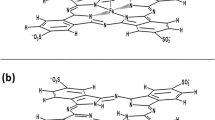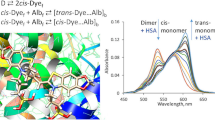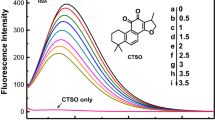The quenching mechanism between chelerythrine (CHE) and keyhole limpet hemocyanin (KLH) was investigated using fluorescence spectroscopy and molecular docking. The experiments were conducted at three different temperatures (293, 298, and 303 K). The results revealed that the intrinsic fluorescence of KLH was strongly quenched by CHE through a static quenching mechanism. The thermodynamic parameters (ΔG, ΔH, and ΔS) of the interaction were calculated, indicating that the interaction between CHE and KLH was spontaneous and that van der Waals forces and hydrogen bond formation played major roles in the binding process. The intrinsic fluorescence of the tyrosine and tryptophan residues in KLH was studied by synchronous fluorescence, which suggested that CHE changed the conformation of KLH. Finally, molecular docking was used to obtain detailed information on the binding sites and binding affinities between CHE and KLH.
Similar content being viewed by others
References
M. Zhong, G. Y. Li, and J. G. Zeng, J. Med. Plants Res., 5, 521–526 (2011).
H. Matthias, Int. J. Pest. Manage., 40, 199–206 (1994).
B. Oliver-Bever, J. E thnopharmacol., 9, 1–83 (1983).
C. Steven J, M. E. Do lan, and A. Cha, Clin. Cancer. Res., 6, 737–742 (2000).
C. M. Laura and B. Enrica, Pharmacol. Res., 33, 127–134 (1996).
D. Heinz and J. Elmar, Dev. Comp. Immunol., 28, 673–678 (2004).
N. M. Whiteley, E. W. Taylor, and A. J. El Haj, J. Therm. Biol., 22, 419–427 (1997).
M. Jürgen, B. Lieb, and W. Gebauer, J. Cancer Res. Clin., 127, R3–R9 (2001).
Y. Z. Zhang, X. Xiang, and P. Mei, Spectrochim. Acta A, 72, 907–914 (2009).
X. Yu, Y. Yang, and X. Zou, Spectrochim. Acta A, 94, 23–29 (2012).
S. Zhu and Y. Liu, Spectrochim. Acta A, 98, 142–147 (2012).
T. Oleg and J. Olson, J. Comput. Chem., 31, 455–461 (2010).
G. Christos and M. Jürgen, J. Mol. Biol., 385, 963–983 (2009).
J. Elmar, K. Buchler, J. Markl, and H. Decker, Biochem. J., 426, 373–378 (2010).
E. Jaenicke, K. Büchler, H. Decker, J. Markl, and G. F. Schröder, Iubmb. Life, 63, 183–187 (2011).
M. Garrett, R. Huey, and W. Lindstrom, J. Comput. Chem., 30, 2785–2791 (2009).
G. Johann and M. Mario, Tetrahedron Lett., 36, 3219–3228 (1980).
B. Sutanwi, A. B. Pradhan, and L. Haque, J. Phys. Chem. B, 120, 5–17 (2015).
M. Fujitsuka, D. W. Cho, and T. Iwamoto, Phys. Chem. Chem. Phys., 14, 14585–14588 (2012).
J. Elmar, K. Büchler, and J. Markl, Biochem. J., 426, 373–378 (2010).
O. K. Abou-Zied and O. I. Al-Shihi, J. Am. Chem. Soc., 130, 10793–10801 (2008).
R. Wang, Y. Xie, and Y. Zhang, Spectrochim. Acta A, 108, 62–74 (2013).
Y. J. Hu, Y. Liu, and R. M. Zhao, J. Photoch. Photobiol. A, 179, 324–329 (2006).
A. Toshio and A. Hiroshi, J. Cell. Biochem., 88, 247–255 (1980).
W. M. Vaughn and G. Weber, Biochemistry, 9, 464–473 (1970).
M. R. Eftink and C. A. Ghiron, J. Phys. Chem., 80, 486–493 (1976).
C. A. Seidel, A. Schulz, and M. H. Sauer, J. Phys. Chem., 100, 5541–5553 (1996).
Y. Pang, Y. Cui, and Y. Ma, IET Micro Nano Lett., 7, 608–612 (2012).
J. Gao, Y. Guo, and J. Wang, Spectrochim. Acta A, 78, 1278–1286 (2011).
Y. J. Hu, Y. Liu, and J. B. Wang, Biomed., 36, 915–919 (2004).
R. G. Machicote, M. E. Pacheco, and L. Bruzzone, Spectrochim. Acta A, 77, 466–472 (2010).
X. Zhao, R. Liu, and Z. Chi, J. Phys. Chem. B, 114, 5625–5631 (2010).
Y. Z. Zhang, B. Zhou, and Y. X. Liu, J. Fluoresc., 18, 109–118 (2008).
Author information
Authors and Affiliations
Corresponding author
Additional information
Published in Zhurnal Prikladnoi Spektroskopii, Vol. 85, No. 2, pp. 305–312, March–April, 2018.
Rights and permissions
About this article
Cite this article
Zhong, M., Long, R.Q., Wang, Y.H. et al. Interaction of Chelerythrine with Keyhole Limpet Hemocyanin: a Fluorescence Spectroscopy and Molecular Docking Study. J Appl Spectrosc 85, 320–326 (2018). https://doi.org/10.1007/s10812-018-0651-3
Received:
Published:
Issue Date:
DOI: https://doi.org/10.1007/s10812-018-0651-3




